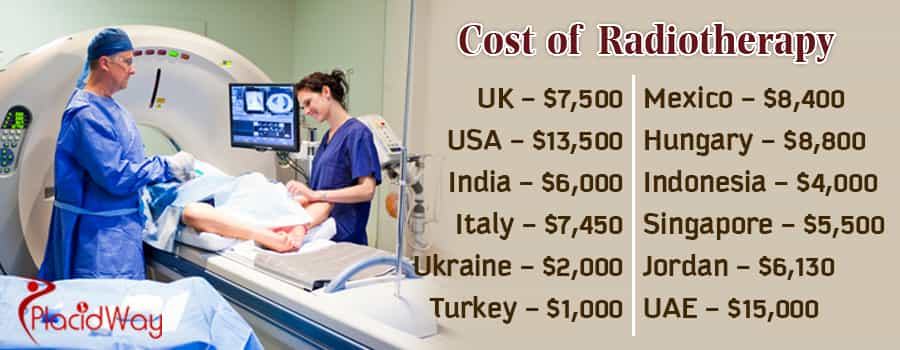
 adiotherapy, or radiation therapy, is a form of treatment used in cancer patients. The treatment uses ionizing radiation in order to damage or kill the cancerous cells. The healthy tissues around the tumorous formations are protected by angling the radiation beams and shooting them into the body so that they intersect the tumor. Radiotherapy is commonly used alongside chemotherapy, but it can also be administered after surgery in order to prevent tumor recurrence.
adiotherapy, or radiation therapy, is a form of treatment used in cancer patients. The treatment uses ionizing radiation in order to damage or kill the cancerous cells. The healthy tissues around the tumorous formations are protected by angling the radiation beams and shooting them into the body so that they intersect the tumor. Radiotherapy is commonly used alongside chemotherapy, but it can also be administered after surgery in order to prevent tumor recurrence.
Types of Radiotherapy
Radiotherapy can be sorted into 2 major types:
Some types of ionizing radiation have more energy than others. The more energy, the more deeply the radiation can penetrate the tissues.
The way each type of radiation behaves is important in planning radiation treatments. The radiation oncologist (a doctor specially trained to treat cancer with radiation) selects which type of radiation is most suitable for each patient’s cancer type and location.
Photon radiation
A high-energy photon beam is by far the most common form of radiation used for cancer treatment. It is the same type of radiation that is used in x-ray machines, and comes from a radioactive source such as cobalt, cesium, or a machine called a linear accelerator. Photon beams of energy affect the cells along their path as they go through the body to get to the cancer, pass through the cancer, and then exit the body.
Particle radiation
Electron beams or particle beams are also produced by a linear accelerator. Electrons are negatively charged parts of atoms. Their low level of energy means that they can’t penetrate as deep into the body, being used mostly in skin treatment or lymph nodes close to the surface of the body
Proton beams are a form of particle beam radiation. Protons are positively charged parts of atoms. They release their energy only after traveling a certain distance and cause little damage to the tissues they pass through. This is why they are considered the least harmful form of radiation for the body, affecting only the cancerous cells at the end of their path.
Neutron beams are used for some cancers of the head, neck, and prostate and for certain inoperable tumors. A neutron is a particle that has no electrical charge. Neutron beam radiation can be useful in some forms of cancer that do not respond to other forms of treatment, but it is also more harmful to the body because they damage the DNA more than proton beams. Also it is very hard to focus neutron beams on a specific part of the body.
Carbon ion radiation can be helpful in treating cancers that don’t usually respond well to radiation (called radio-resistant). It’s also called heavy ion radiation because it uses a particle that’s heavier than a proton or neutron. The particle is part of the carbon atom contains protons, neutrons and photons, and just like in the case of a proton beam, it can be set to affect only the cells at the end of its path. The downside of this form of radiation is that the healthy tissue around the target area can be severely damaged.
Radiotherapy can also be split into two categories, depending on where the radiation comes from:
External radiotherapy
External radiotherapy is the most common type of radiotherapy used. It is usually administered as a course of several treatments over a period of several days or weeks. A machine directs the high-energy radiation at the cancer site and a small area of normal tissue surrounding it. The patient is positioned on a treatment couch and then the machine will be directed exactly at the area to be treated, often from different angles. Treatment takes several minutes and is painless.
The CyberKnife is a sophisticated robotic external radiotherapy system given over a shorter period of time. However, it is not suitable for all tumours and you can ask your doctor if your case is suitable.
External radiotherapy doesn’t leave radioactive residues in or on the body.
Internal radiotherapy
Internal radiotherapy can be administered in several ways.
Brachytherapy is treatment in which solid radioactive source are placed inside a body cavity or needles are inserted in the tumour. This is usually given on an outpatient basis but may involve staying in hospital for a few days until the radioactive source has been removed.
Radionuclide (radioisotope or unsealed source) radiotherapy involves using a liquid source of radiation. It can either be administered orally or given in the form of injections. For this type of treatment, the patient will need hospitalization for a few days until most of the radioactive residue in his body has disappeared.
Occasionally, with radioactive treatment or with treatment with radioactive ‘seeds’, you will be emitting a certain amount of radioactivity for a few days.

Radiotherapy risks and benefits
Risks
Radiotherapy can damage or destroy normal cells as well as cancer cells and can cause treatment side effects, most of which are temporary. There may be a small risk of long-term, or late, permanent effects from radiotherapy. However, side effects are rarely severe.
Pregnancy is not advised before or during radiotherapy because it may injure the fetus, especially in the first three months of the pregnancy. Also, men are advised against fathering a child during radiotherapy and for a few months afterwards.
Benefits
The purpose of radiotherapy is to destroy cancer cells while causing as little damage as possible to normal cells. It can be used to treat many kinds of cancer in almost any part of the body.
Curative treatment, which is sometimes called radical treatment, aims to give long-term benefits to cancer patients. Radiotherapy may be given before surgery to shrink a tumour or after surgery in order to prevent the regrowth of cancer cells that may remain. It can also be given before, during or after chemotherapy or hormone treatment to improve overall results.
Used as a palliative treatment it aims to shrink tumours and reduce pain or relieve other cancer symptoms. Palliative radiotherapy may also prolong life.

What is the cost of radiotherapy?
UK – $7,500, USA – $13,500, India – $6,000, Italy – $7,450, Ukraine – $2,000,
Turkey – $1,000, Mexico – $8,400, Hungary – $8,800, Indonesia – $4,000,
Singapore – $5,500, Jordan – $6,130, UAE – $15,000
Get in touch with us and find out more about your options!
Cancer Treatment Abroad, Breast Cancer, Lung Cancer